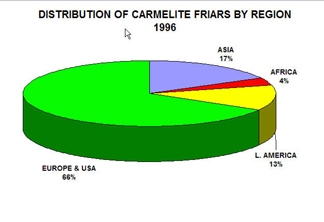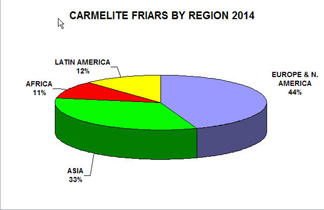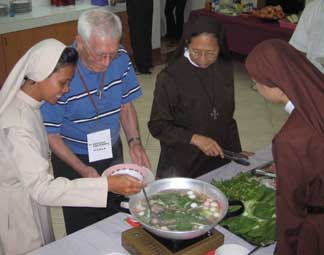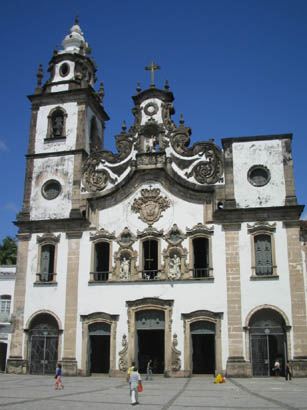|
no. 4 october - december 2005 As you can read from other parts of CITOC, the General Congregation seems to have been a success. The General Congregation is mandated by the Constitutions and is to be held two years before the General Chapter. The major focus of the meeting was to look towards the future and try to prepare ourselves as an Order to meet the challenges that lie ahead. The General Council planned this meeting in São Paulo with a view to the General Chapter in September 2007. The participants shared their views on possible themes for the General Chapter and the General Council finally chose: In Obsequio Jesu Christi: Praying and Prophetic Community in a Changing World. As was agreed at the General Congregation, various representatives of the Carmelite Family will be invited to participate in a section of the General Chapter in order to enrich our understanding of our charism. Everyone will be able to send in suggestions and proposals through the Preparatory Commission and by means of a dedicated web site during the Chapter itself. The theme of the Chapter is forward looking. Basing ourselves on what is fundamental to the Christian life (the following of Christ), we want to study together the Carmelite charism in relation to our world which is changing at an ever more rapid rate. At the General Congregation we looked at the impact of demographics on our Order and we focused on what we have to do today in order to faithfully transmit the charism tomorrow. As we prepare for the General Chapter, which is a very important event in the life of the Order, perhaps we could all ponder the following question: What does it mean to be a prayerful community in the many different cultures in which Carmel finds itself and how can our presence be a prophetic sign? The webpage of the General Chapter: carmelites.info/general_chapter 1996-2014 Numbers Indicate Shift
Charts showing the percentages of Carmelites in each region in 1996 as compared with projections for 2014 indicate Asia going from 17% to 33% of the Orders members. Africa almost triples its percent going from 4% to 11%. Europe and North America decrease from 66% to 44% of the Order’s membership. Latin America is projected to decrease by 1% in the same time period. (Stats courtesy of General Secretariat)
The Status Ordinis, the directory of all the members and houses of the Order throughout the world, tells the story. The Carmelite presence in Asia is growing and the number of students in formation appears to indicate that this will continue for the near future. Africa has approximately 190 men in studies, Latin America has 180 and Northern Europe and North America have approximately 50. The Asian region has 380 or almost half of the total number of Carmelites in formation. In 2005, there are two monasteries of enclosed nuns in Indonesia and seven monasteries in the Philippines. The Carmelite Family too has a large presence in the Asian region. In Indonesia, one finds the Hermanas de la Virgen María del Monte Carmelo, the Putri Karmel, the Congregation of St. Elijah, the Lay Carmelites and the Holy Trinity Community which is the lay branch of the Putri Karmel. The Istituto di Nostra Signora del Carmelo is present in India. The Philippines is home to the Carmelite Sisters of Our Lady, the Congregation of Our Lady of Mount Carmel, the Suore Carmelitane Missionarie di S. Teresa del Bambino Gesù, and the Donum Dei. Donum Dei is present in Vietnam. In Timor Leste, the Hermanas de la Virgen María del Monte Carmelo has foundations. In New Caledonia, Wallis, and Futuna, the Donum Dei has foundations. 1) Some of the various branches of the Carmelite Family in Asia, the fastest growing area of the Order, during the meeting of the Carmelite NGO in February 2005 included members of three Provinces, Putri Karmel, the Congregation of St. Elias, the Hermanas de la Virgen María del Monte Carmelo and the Congregation of Our Lady of Mount Carmel. (CITOC photo)
In 1982, the Province of Pernambuco had already been tagged with the title "Smallest Province in the Order" for a number of years. But now the Carmelite Province in northeastern Brazil found its very existence called into question. Two key members had died in 1965. The rector of the seminary died a few years later. Six of the remaining twenty members of the Province left the Order. In 1982, Paulo Cardoso da Silva was elected Prior Provincial and with the support of the rest of the Province set out to find new vocations. The turnaround in vocations was nothing short of a miracle. The story of how this was done was told to the members of the recent General Congregation in São Paulo, Brazil. "What was done about vocations in Pernambuco cannot be copied in other Provinces of the Order. That is not our intention for having this presentation to the General Congregation," said Joseph Chalmers in his introduction to the presentation on vocation ministry. "But perhaps there are some concepts from the success in Pernambuco that can be taken back to your own Province." That success was a vocation project called "Inter-Carmelite Vocation Days." Far from being a passive vocational experience, it is now called "a vocational offensive." It included the Province of Rio and the Provincial Commissariat of Paraná and religious women affiliated with the Discalced Carmelites as well. "It was somewhat self-centered," admits Paulo Cardoso, now the bishop of Petrolina. "We focused on recruiting young men and women to our Order. The simple people of God taught us to adapt the program to have a more missionary focus." The change meant focusing more on taking care of the needs of the people and less on filling the ranks. A number of candidates began to appear. The young people themselves became the vocation workers. The Pernambuco Province suddenly found itself in unfamiliar territory. It was no longer the smallest province of the Order. "Formation then became the major concern," explains Bishop Cardoso. "But the answer came with joint formation between ourselves and the Rio Province and the Paraná Commissariat. The program is remarkably simple. A "vocation team" of nine friars (four simply professed and five solemnly professed visit an area. They promote days of reflection. A welcome is provided to those who seem to be looking for something deeper in their lives. Four vocational meetings are then held for those who have expressed interest. The first one occurs at the beginning of the year and is open to all regardless of age. It is held in one of the houses of the Province and lasts for four days. From that meeting some are selected to be invited for a more in-depth experience. The process is then repeated for two additional meetings. The members of the vocation team lead discussions that focus on four areas: family, psychological, relationships, and the level of participation of the candidates in their local Church. A personal visit to the candidate’s home by a team is also made. The criteria used in the program centers on the personal, community, ecclesial, spiritual dimensions along with a knowledge of religious life. During the presentation by Bishop Cardoso and Francisco de Sales, the current Prior Provincial of the Pernambuco Province, several challenges to the process were mentioned. These included the increasing misunderstanding of religious life by the young as a means of status or as a life of pious practice. The need for the members of the Province to offer witness that attracts and to offer a challenging life remains a difficult achievement. Bishop Cardoso also voiced the need to recover the commitment to the poor as central to the success of any Province. The program is revised every three years. History is not supposed to repeat itself. But in 1984, the former Carmelite Provincial and now Bishop arrived in his new Diocese of Petrolina to find himself with 15 mostly elderly priests and 31,000 square miles of diocese. Instituting a program similar to the "Inter-Carmelite Vocation Days," the Diocese of Petrolina now has 40 priests with the average age below 40 years. In a couple of years, the number of priests in the diocese will reach 50. There are 30 candidates in the seminary. Five are deacons. At the end of the presentation, the question was posed "Is the problem a shortage of vocations or is it a lack of hunger for the Kingdom of God?" 2007 General Chapter Preparatory Commission Announced The Prior General and his Council in session 203 held on 13 October 2005 appointed the Preparatory Commission for the 2007 General Chapter. The following h= ave generously agreed to serve: Christian Körner (GerS), Francisco De Sales (Pern), Michael Kissane (SEL–NY), Giovanni Grosso (Ita), John Keating (Hib), Josué Ghizoni (GerS–P), Chelo Debbi (Ita–C) and Heribertus Purwanto (Indo) The first meeting of the Commission will be in CISA from 6 to 12 March 2006, and on 7 March the Commission will meet with the General Council in the Curia during its plenary session. The webpage of the General Chapter: carmelites.info/general_chapter |
|
RETURN TO THE INDEX FOR 2005 | RETURN TO THE INDEX FOR THIS ISSUE INDEX OF CARMELITE
WEBSITES |




